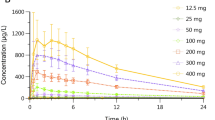Summary
The pharmacodynamics and pharmacokinetics of atorvastatin, an HMG-CoA reductase inhibitor, were characterized in 16 healthy subjects following administration of 10 mg atorvastatin tablets with, or 3 h after, evening meals for 15 days in an open-label, randomized, 2-way crossover study. Atorvastatin was well tolerated. Atorvastatin administration with evening meals resulted in 25.2% lower mean Cmax and 29.8% longer mean, tmax values relative to administration after meals. The mean AUC0−24 value was 8.6% lower for atorvastatin administration with meals compared to after meals. In contrast to the effect of food on pharmacokinetics, LDL-C reductions were similar after atorvastatin administration with or after evening meals. Average reductions from baseline were 24.4% for total cholesterol, 39.6% for LDL-C and 10% for triglycerides. Therefore, atorvastatin may be administered with or without food.
Similar content being viewed by others
References
Nawrocki J.W., Weiss S.R., Davidson M.H. et al. (1995): Reduction of LDL-cholesterol by 25% to 60% in patients with primary hypercholesterolemia by atorvastatin, a new HMG-CoA reductase inhibitor. Arterioscler. Thromb. Vasc. Biol., 5, 678–682.
Radulovic L.L., Cilla D.D., Posvar E.L., Sedman A.J., Whitfield L.R. (1995): Effect of food on the bioavailability of atorvastatin, an HMG-CoA reductase inhibitor. J. Clin. Pharmacol., 35, 990–994.
Shum Y.Y., Huang H., Walter G.A. et al. (1993): Development and validation of an enzyme inhibition assay for quantitation of CI-981 in human plasma [abstract PPDM 8467]. Pharm. Res., 10 (Suppl.), S-415.
Friedewald WT., Levy R.I., Fredrickson S.D. (1972): Estimation of the concentration of low-density cholesterol in plasma, without use of preparative ultracentrifuge. Clin. Chem., 18, 499–502.
SAS Institute: SAS Users Guide. Statistical Version, 5th edn. Cary, NC: SAS Institute, 1987.
Smith H.T., Jokubaitus L.A., Troendle A.J., Hwang D.S., Robinson W.T. (1993) Pharmacokinetics of fluovastatin and specific drug interactions. Am. J. Hypertens., 6, 375S-382S.
Deslypere J.P. (1994): Clinical implications of the biopharmaceutical properties of fluvastatin. Am. J. Cardiol., 73, 12D-17D.
Pan J., DeVault A., Glaess S. et al. (1993): Effects of food on the pharmacokinetics and pharmacodynamics of pravastatin, an HMG CoA reductase inhibitor [abstract]. Arteriosclerosis, 8, 588a.
Pan H.Y., DeVault A.R., Brescia D. et al. (1993): Effect of food on pravastatin pharmacokinetics and pharmacodynamics. Int. J. Clin. Pharmacol. Ther. Toxicol., 31, 291–294.
Physicians’ Desk Reference: PDR. Oradell, NJ: Medical Economics, 1999.
Author information
Authors and Affiliations
Rights and permissions
About this article
Cite this article
Whitfield, L.R., Stern, R.H., Sedman, A.J. et al. Effect of food on the pharmacodynamics and pharmacokinetics of atorvastatin, an inhibitor of HMG-CoA reductase. Eur. J. Drug Metab. Pharmacokinet. 25, 97–101 (2000). https://doi.org/10.1007/BF03190074
Received:
Issue Date:
DOI: https://doi.org/10.1007/BF03190074




